View From the Couch: The Emerald Forest, Point Break, etc.
View From The Couch is a weekly column that reviews what’s new on Blu-ray, 4K and DVD.
 FILM FRENZY
FILM FRENZY
Your source for movie reviews on the theatrical and home fronts
View From The Couch is a weekly column that reviews what’s new on Blu-ray, 4K and DVD.
Ronald Reagan in Point Break (Photo: Shout!)
By Matt Brunson
For a review of this week’s 4K UHD release of TITANIC, go here.
(View From The Couch is a weekly column that reviews what’s new on Blu-ray, 4K and DVD. Ratings are on a four-star scale.)
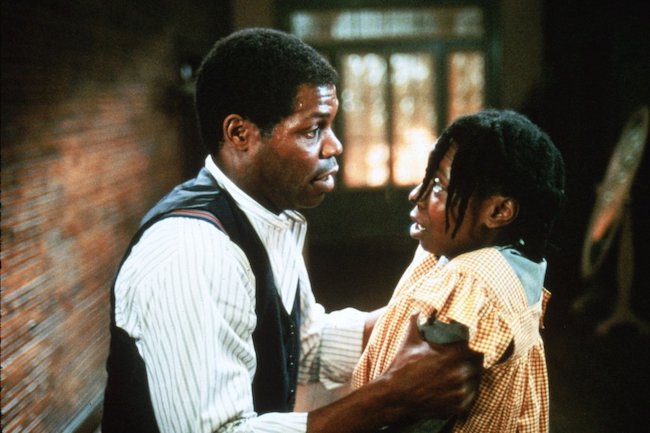
THE COLOR PURPLE (1985). After years spent making fantastic popcorn pictures like Jaws, Raiders of the Lost Ark, and E.T. the Extra-Terrestrial, Steven Spielberg decided to direct what was considered his first “serious” picture. His adaptation of Alice Walker’s Pulitzer Prize-winning novel was highly controversial, earning harsh reviews from several major critics, a condemnation from the NAACP, and even a famous dismissal by an industry insider who accused Spielberg of taking great source material and turning it into a “zip-a-dee-doo-dah Song of the South.” On the other hand, the film did land on numerous critics’ “10 Best” lists (including that of Roger Ebert, who had it in the No. 1 slot), grossed nearly $100 million at the box office, and snagged a whopping 11 Oscar nominations, including one for Best Picture … but not for Spielberg as Best Director. (The movie still holds the record, tied with 1977’s The Turning Point, for earning the most Academy Award nominations without winning a single award.) Watching it again today, it’s clear that this represents one of Spielberg’s least confident turns behind the camera, as marked by the jarring shifts in tone during the picture’s first half — scenes wildly fluctuate between, say, put-upon Celie (Whoopi Goldberg) cowering in fear from the abusive Albert (Danny Glover), and Albert’s son Harpo (Willard Pugh) repeatedly crashing through a roof like a latter-day Keystone Kop. But thanks to the performers, most notably the trio of Oscar nominees — Goldberg, Oprah Winfrey (in her film debut as the fiery Sofia), and Margaret Avery (as songstress Shug Avery) — the movie gains in strength the longer it plays out, with the second half housing some extremely powerful moments.
Extras in the 4K + Digital edition include a making-of featurette; a piece on casting the film; and a discussion of the music.
Movie: ★★★
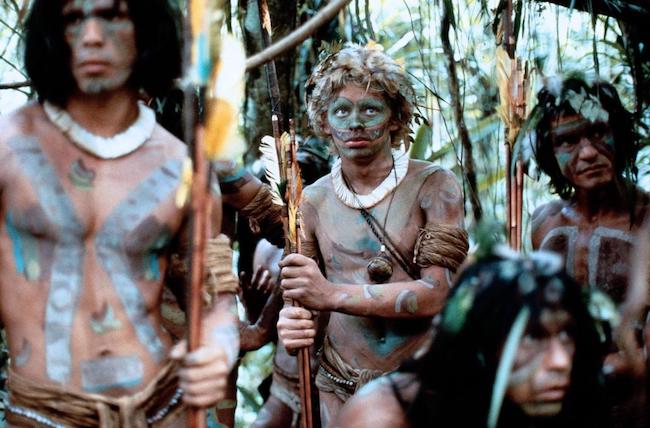
THE EMERALD FOREST (1985). Here’s a “save the rainforest” film that succeeds so well as an adventure yarn and as a familial drama that one might forget about its pro-environmental slant until the closing text helpfully brings it back to the forefront. Powers Boothe stars as Bill Markham, an American engineer who has moved to Brazil to work on a dam being constructed next to a rainforest. Since it’s a lengthy assignment, he’s brought along his wife Jean (Meg Foster) and two small children to live with him, but tragedy strikes when the members of a peaceful indigenous tribe called the Invisible People snatch their young son Tommy. Bill and Jean spend 10 years looking for their boy, to no avail. Meanwhile, Tommy is now a teenager (played at this point by Charley Boorman), having been fully absorbed into the tribe and given the name Tomme. Bill and Tommy/Tomme are finally reunited, but it’s under less than desirable circumstances, as both find themselves being pursued by cannibalistic tribesmen known as the Fierce People. I suppose nepotism isn’t really nepotism when the casting choice works beautifully, and that’s the case here — director John Boorman (Deliverance) chose his own son Charley to play Tommy, and the boy delivers an exceptional performance in this demanding role. The story grows more contrived as it enters its second half — the Fierce People form an alliance with European brothel owners, thus doubling the film’s quota of villains, and Tommy leaves the wilds to take a trip to the big city (so, like Crocodile Dundee but without the laughs). But the thrills are interspersed with a rumination on what defines family, and the cinematography by Philippe Rousselot (Oscar winner for A River Runs Through It) is striking.
Blu-ray extras consist of film historian audio commentary and the theatrical trailer.
Movie: ★★★
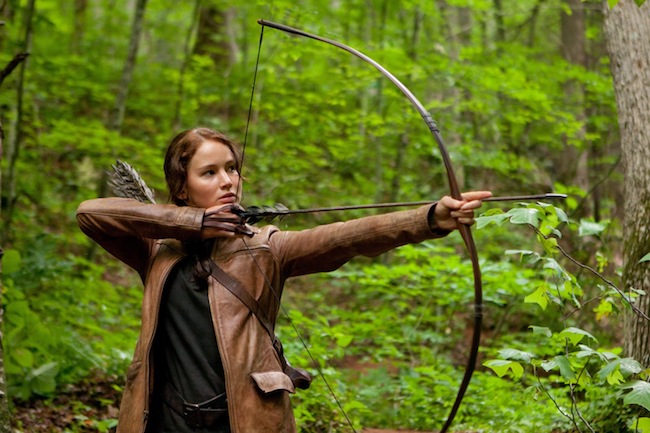
THE HUNGER GAMES 4-MOVIE COLLECTION (2012-2015). “But wait!” you sputter. “Haven’t the first four films in The Hunger Games series already been released on Blu-ray and 4K, separately or together, about a dozen times?” Correction, dear couch potato: By my (admittedly incomplete) tally, they’ve been released about three dozen times in the two formats. However, with the current prequel The Hunger Games: The Ballad of Songbirds & Snakes headed to homes in early 2024, and with Christmas and the attendant shopping season upon us, Lionsgate has opted to offer the quartet in a handsome steelbook package containing 4K copies, Blu-ray copies, and Digital copies.
The smash adaptation of Suzanne Collins’ smash bestseller, The Hunger Games (2012) largely delivers on both its provocative premise and its exciting execution. Set in a future world where the ruling one percent long ago squashed a rebellion by the 99 percent, the law dictates that, as perpetual punishment, those once-radical districts — 12 total — must annually send two young “tributes” to participate in the Hunger Games, a televised ritual in which all 24 contestants are set loose in the outdoors and must kill each other until only one remains. The representatives for District 12, the most impoverished of the outer regions, turn out to be the headstrong Katniss Everdeen (Jennifer Lawrence) and the meek Peeta Mellark (Josh Hutcherson). The lengthy first act is compelling, anchored by the strong central performance of Lawrence and reveling in the introduction of such memorable characters as unctuous TV host and broadcaster Caesar Flickman (Stanley Tucci), flighty tribute chaperone Effie Trinket (Elizabeth Banks), ruthless President Snow (Donald Sutherland), and, providing some grizzled heart and off-the-cuff humor, Haymitch Abernathy (Woody Harrelson), whose status as the only District 12 representative to ever win a tournament allows him to serve as the boozy mentor to Katniss and Peeta. The second half is less successful, with the staging of the winner-take-all competition not as impactful or exciting as expected. At the U.S. box office, the film was a box office blockbuster, with only The Avengers and The Dark Knight Rises grossing more that year. The song “Safe & Sound,” co-written and sung by newly anointed TIME Person of the Year Taylor Swift, earned a Grammy Award for Best Song Written for Visual Media.
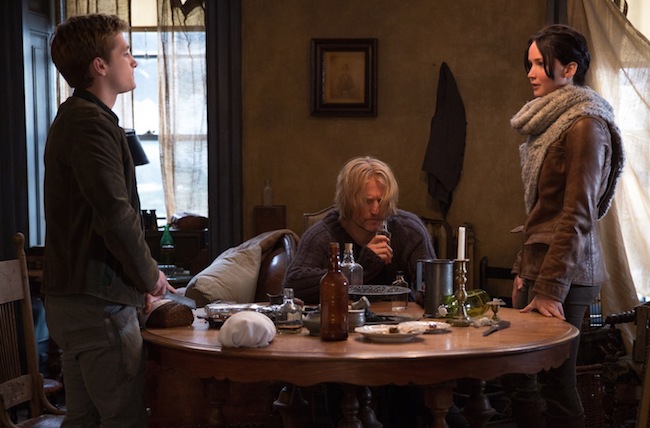
Bucking the laws of diminishing returns when it comes to sequels, The Hunger Games: Catching Fire (2013) is superior to its predecessor — in fact, it’s the best film in the series. It picks up where the first film left off, with Katniss and Peeta back at home in District 12 after winning the 74th annual Hunger Games. But in the Capitol, President Snow senses in Katniss the spark needed for a revolution, so, at the urging of the latest Games designer (Philip Seymour Hoffman), he decides that it’s back to the killing fields for the pair. One of the aspects that makes Catching Fire stronger than its predecessor is that it possesses a more palpable sense of danger. For all the kid-on-kid brutality in the first film, it truly felt like a “game,” as these teens and preteens ran around the forest picking up skills while picking each other off. But in this picture, the tension is heightened on every front. As again portrayed by a chilling Sutherland, President Snow is a deadly adversary, far more threatening than anything the Hunger Games can conjure up (be it the wasps in the first film or a tidal wave in this one), and his malevolent presence hangs over all 12 districts like a poisonous fog. Katniss Everdeen continues to be a fantastic heroine, and her appeal is only accentuated by the intuitive and commanding work by Lawrence in the role. As befits its series-best status, this was the top-grossing movie of 2013, outpacing runners-up Iron Man 3 and Frozen.
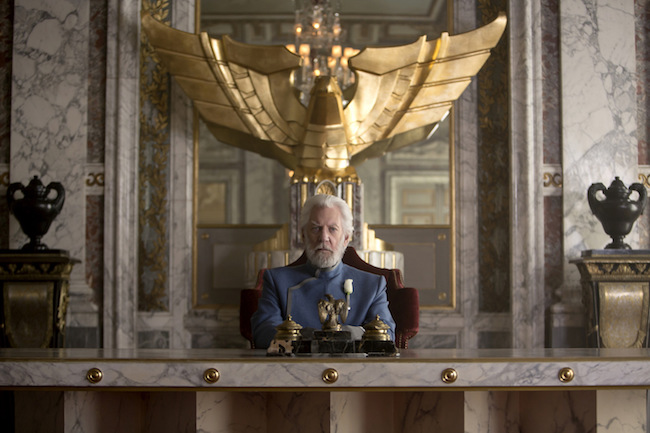
Until Clint Eastwood’s The Passion of the Sniper — excuse me, American Sniper — finally surpassed it, The Hunger Games: Mockingjay — Part 1 (2014), an adaptation of the first half of the final book in the series, was the top moneymaker of 2014. The last novel in the Harry Potter series was split into two pictures, and while Harry Potter and the Deathly Hallows: Part I was enjoyable, it still felt like a case of too much narrative padding, with most of the highlights reserved for Part 2. That, in a nutshell, is also what happens with Mockingjay — Part 1, as there’s an unavoidable sensation of treading water, of biding time before Part 2. Yet for all its stop-and-start pacing, there’s still plenty worth catching, beginning with Lawrence’s continued strong work in the franchise. She once again excels as Katniss, who, as we saw at the end of Catching Fire, has been plucked by members of the rebellion to lead their uprising against President Snow and his fascistic government. Any film that decreases screen time for Harrelson (again playing boozy Haymitch Abernathy) and increases it for Liam Hemsworth (as heroic Gale Hawthorne) is tempting fate — and critics — but for the sake of the narrative, these modulations make sense, as Katniss suffers from post-traumatic stress disorder and needs her best buddy/semi-boyfriend frequently on hand to calm her down.
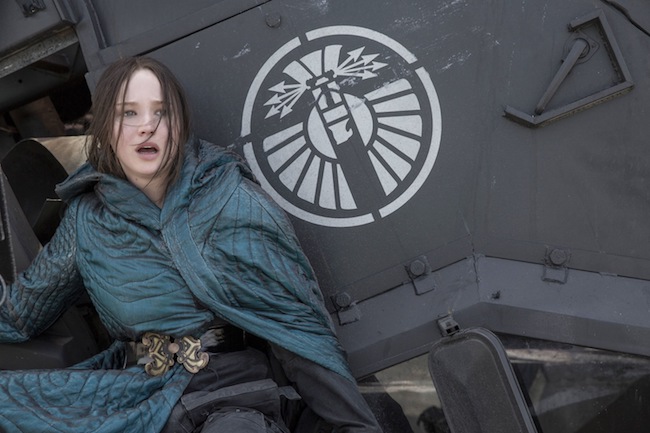
While The Hunger Games: Mockingjay — Part 2 (2015) boasts the same problems as many other closers in multi-part franchises — namely, the decreased use of audience favorites (see: Hagrid in the Harry Potter series) and a needlessly protracted finale (hello, The Lord of the Rings!) — it nevertheless provides a satisfying conclusion to this durable series. Picking up where Part 1 left off, we find Katniss dealing with a Peeta who’s been programmed to kill her (alas, Hutcherson is simply not up to the rigorous demands the role now requires), a President Snow who’s determined to crush her, and a district leader (Julianne Moore) whose end game grows more suspicious by the minute. Meanwhile, Katniss’ puppy dog of a part-time lover, Gale, continues to hang around seeking scraps of affection, while the most interesting players —Sam Claflin’s Finnick, and Jane Malone’s Johanna among them — are lucky to be given a scene here, a line there. Aside from some outlandish moments toward the end, such as when the creatures from The Descent unexpectedly show up, the picture benefits from its relentless bleakness, as decent people die unexpectedly, personal traumas continue to haunt many of the characters, and Katniss learns that when it comes to government, plus ça change, plus c’est la même chose. The Hunger Games franchise is often dismissed for its Young Adult designation, but as far as these film versions are concerned, they often showcase a maturity and sobriety that put many Old Adult efforts to shame. Although still a financial success, this didn’t hit the highs of its predecessors, finishing #7 for the year.
The set promises over 10 hours of bonus features, including audio commentaries, making-of features, and deleted scenes.
The Hunger Games: ★★★
The Hunger Games: Catching Fire: ★★★½
The Hunger Games: Mockingjay — Part 1: ★★★
The Hunger Games: Mockingjay — Part 2: ★★★
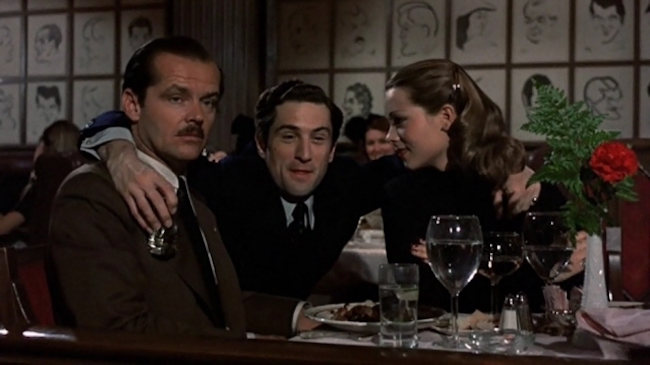
THE LAST TYCOON (1976). After The Last Tycoon opened to mixed reviews and nonexistent box office, Sam Spiegel (producer of Best Picture Oscar winners On the Waterfront, The Bridge on the River Kwai, and Lawrence of Arabia) lamented, “The greatest young actor in America today is Robert De Niro, the greatest living director is Elia Kazan, and I may be the greatest producer of all time. How the hell could we make such a bad fucking movie?” Truthfully, this adaptation of F. Scott Fitzgerald’s unfinished novel is more of an interesting misfire than a “bad fucking movie” — even just among 1976 releases set in Hollywood’s golden past, it may not be as good as Peter Bogdanovich’s underrated Nickelodeon but it bests Gable and Lombard and Won Ton Ton, the Dog Who Saved Hollywood. Guided by Kazan (his final film) and scripter Harold Pinter, Robert De Niro provides a nicely understated turn as Monroe Stahr, a workaholic studio head (based on MGM head Irving Thalberg) whose utter devotion to his job gets interrupted when he falls for Kathleen Moore (Ingrid Boulting), a young woman who reminds him of his late wife. There are some excellent individual scenes floating around, but Pinter never finds a way of making the central romance interesting — as such, these dreary interludes between Monroe and Kathleen repeatedly drain the picture of its already minimal momentum. The cast is packed with all-stars — Robert Mitchum as a jovial producer, Tony Curtis as a popular actor, Donald Pleasence as a befuddled writer, etc. — with top honors going to De Niro, Jack Nicholson as a Commie union leader, and, in her film debut, Theresa Russell as Mitchum’s astute daughter. This earned an Oscar nomination for Best Art Direction-Set Decoration.
The only Blu-ray extra is audio commentary by a notoriously self-important and supercilious film historian.
Movie: ★★½
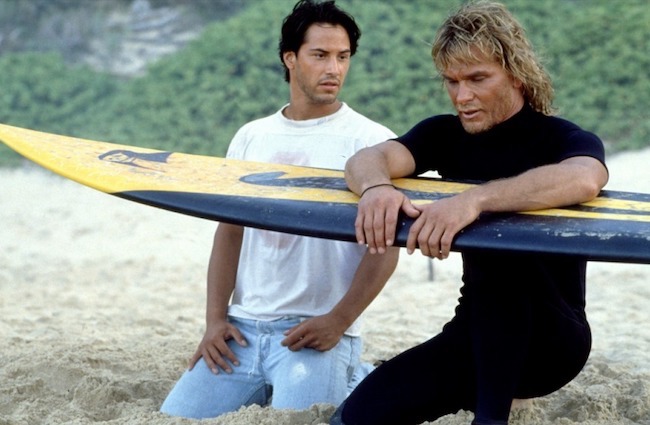
POINT BREAK (1991). In reviewing 1989’s Road House earlier this year for its 4K debut, I wrote, “It’s dopey beyond measure, but the action sequences are impressive, and, besides, its knuckleheaded approach is part of its (admittedly limited) appeal.” I also noted in my 2½-star assessment that “I recall giving this 1½ stars when I initially screened it at the start of my career, meaning time has made me either more mellow or more moronic.” Those exact lines can equally be applied to Point Break, and the fact that both movies star Patrick Swayze surely must represent some sort of cosmic reckoning, the type best appreciated by the New Age surfer dude played here by the Dirty Dancing star. Keanu Reeves stars as Johnny Utah (presumably no relation to Joe Montana), a rookie FBI agent out to bust some surfers who rob banks to finance their endless summers. Since the crooks wear masks of ex-Presidents while pulling off their heists, their identities are unknown — in an effort to crack the case, Johnny infiltrates the surfer community and falls in with a likely group of suspects led by Bodhi (Swayze), a beach bum constantly mumbling pseudo-philosophical catchphrases connecting surfing with the preservation of the human spirit. Director Kathryn Bigelow, later an Oscar winner for The Hurt Locker, is here coming off 1990’s awful Jamie Lee Curtis actioner Blue Steel — while that picture found her constantly positioning gleaming revolvers as phallic symbols, she does not follow that line of thought with this film’s long and stiff surfboards. Instead, she focuses on thrilling action set-pieces — the skydiving sequences are particular spectacular, and they live up to the film’s tagline of “100% Pure Adrenaline.” The rest, however, is 100% Pure Hokum. Killer closing song by Ratt, though (“Nobody Rides for Free”).
Extras in the 4K UHD + Blu-ray edition include a making-of featurette; additional scenes; and the theatrical trailer.
Movie: ★★½
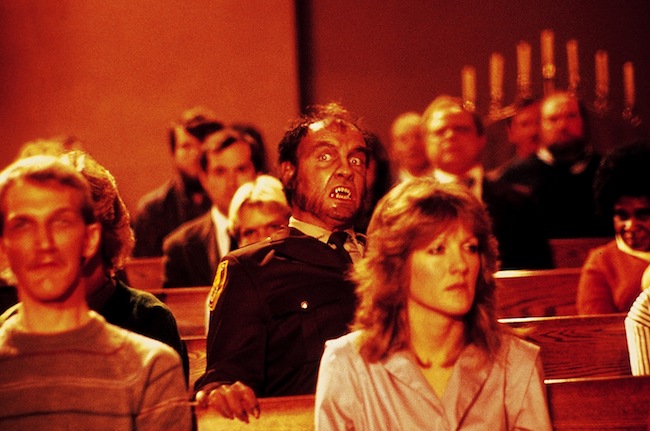
SILVER BULLET (1985). Stephen King adapted his own novella Cycle of the Werewolf, but the end result is nothing to howl about. A werewolf is running loose in a small town, and the only ones seemingly able to stop it are a wheelchair-bound young boy (Corey Haim), his older sister (Megan Follows), and their boozy Uncle Red (Gary Busey). Everett McGill, Twin Peaks’ Big Ed Hurley, co-stars as the local reverend, while Terry O’Quinn, Lost’s John Locke, appears as the town sheriff. Daniel Attias, directing his first and last feature film (he would then enjoy a successful career on television, helming multiple episodes of such hits as Alias, The Wire, and Homeland), tries his best to milk suspense out of the premise, but the problem is King’s often dopey screenplay. Not only is the identity of the werewolf immediately obvious, but his motives are muddled and never really make sense. A talented cast does its best to survive King’s often clunky dialogue, with Haim and Follows both highly appealing and Busey enlivening the proceedings as the animated uncle whose drinking problem never interferes with his bond with his paraplegic nephew. As was common in the 1970s and ‘80s, the two most despicable characters emerge unscathed, with nary a werewolf scratch on them; while this denies viewers some much-needed catharsis, it does make the victim list slightly more unpredictable. This was produced by Dino De Laurentiis’ wife Martha De Laurentiis, with all of the filming taking place at his studio in Wilmington, NC, and surrounding areas.
Extras in the 4K + Blu-ray edition include audio commentary by Attias; audio commentary by Martha De Laurentiis; interviews with McGill, supporting actor Kent Broadhurst (who plays the father of a teenage victim), editor Daniel Loewenthal, and special effects artists Matthew Mungle and Michael McCracken; and a still gallery.
Movie: ★★
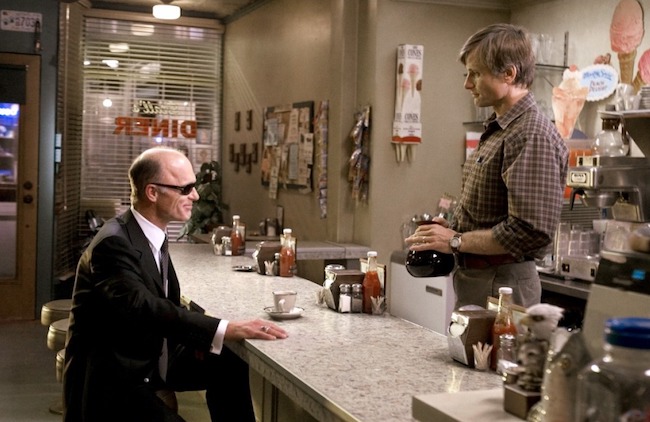
FROM SCREEN TO STREAM
A HISTORY OF VIOLENCE (2005). A Canadian filmmaker, David Cronenberg here resembles nothing so much as one of his fellow countrymen glimpsed in Michael Moore’s Bowling for Columbine, gazing at our land across the lakes and wondering why we’re always so obsessed with carnage. In much the same manner that David Lynch deconstructed the myth of the squeaky-clean small Southern town in Blue Velvet, so too does Cronenberg take a hatchet to the façade of bland Midwestern homeliness. His protagonist is Tom Stall (Viggo Mortensen), a family man who becomes a national hero after killing two psychos in self-defense. But the exposure brings a stranger to town, a gruff mobster (Ed Harris) who insists that Tom was once a homicidal kid back in Philadelphia. Cronenberg and scripter Josh Olson (deservedly earning an Oscar nomination for adapting a graphic novel by John Wagner and Vince Locke) create a dizzying examination of this country’s love-hate affair with brutality, exploring numerous gray areas with the help of a powerhouse cast. William Hurt earned a Best Supporting Actor Oscar nod for his hammy (albeit effective) turn as a Philly crime kingpin, but top honors belong to Maria Bello as Tom’s wife, who’s both aroused and frightened by the mystery surrounding her husband’s identity, and Harris, who brings genuine menace to his role as a scar-faced killer.
Movie: ★★★½